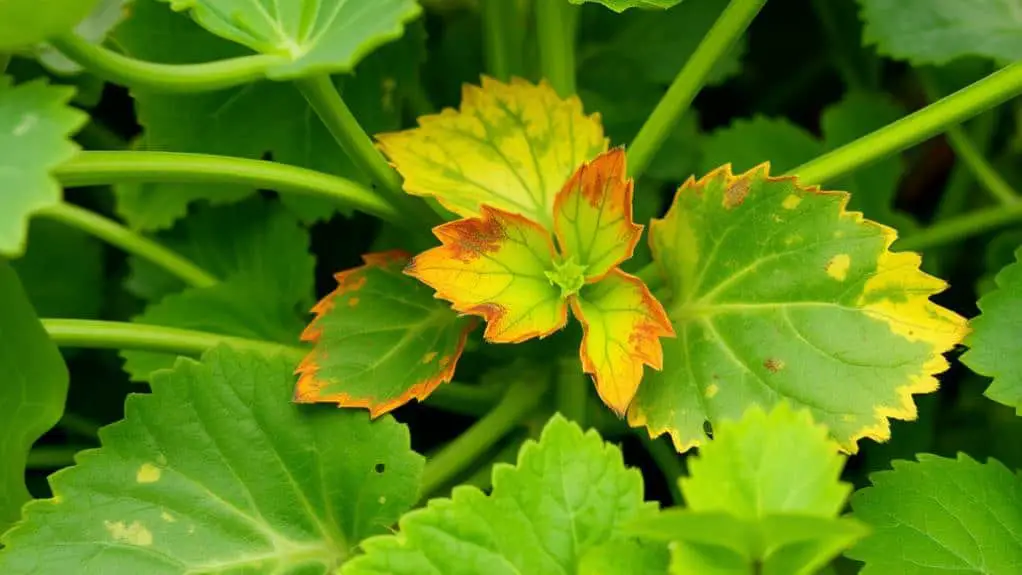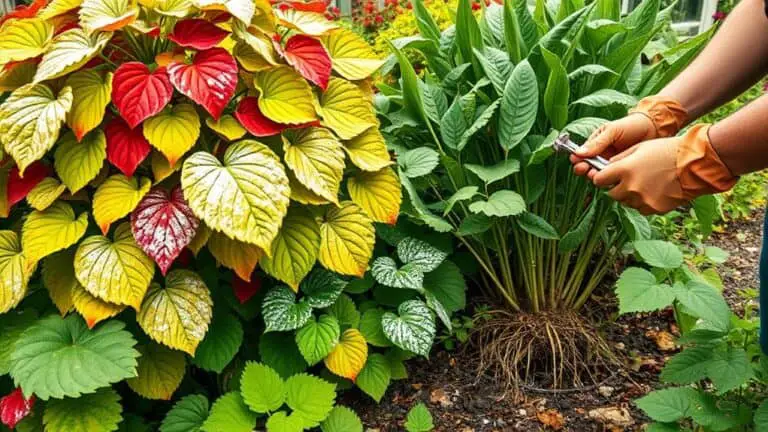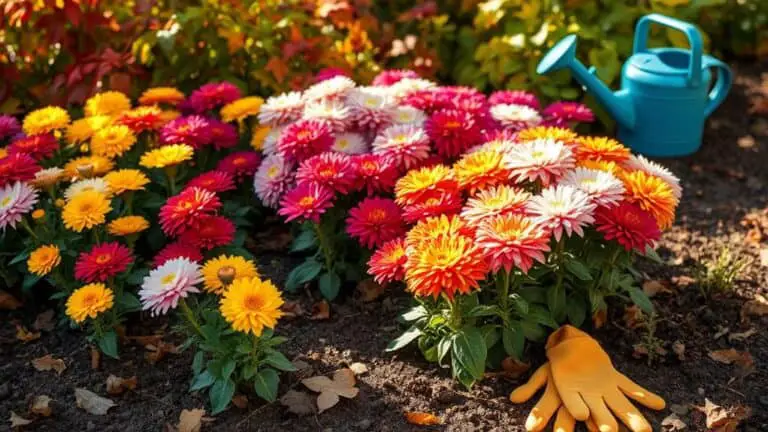Why Your Zucchini Plant Leaves Are Turning Brown
I've noticed that your zucchini plant leaves are turning brown, and there could be several reasons behind this issue. From inconsistent watering to pest infestations like squash vine borers and squash bugs, the causes can be varied and complex. You might also be dealing with diseases such as powdery mildew or nutrient deficiencies that affect the plant's overall health. Environmental stress and even overwatering can contribute to this problem too. Let's explore these potential culprits in more detail so you can bring your zucchini plants back to their vibrant, green selves.
Under Watering

When zucchini plant leaves start turning brown, one of the primary culprits could be underwatering. Zucchini plants aren't drought tolerant and need consistent soil moisture, especially during hot days.
If you notice yellowing leaves or wilting, check the soil moisture first. Dry, brown leaves mean severe underwatering, so it's time for immediate action.
I've found that a layer of mulch around my zucchini plants helps retain soil moisture, reducing how often I need to water.
Regularly monitoring soil moisture is vital. Stick your finger into the soil; if it feels dry beyond the top inch, it's time to water.
Keeping the soil consistently moist guarantees healthy, productive zucchini plants, preventing those dreaded brown leaves.
Squash Vine Borer
Underwatering isn't the only challenge zucchini plants face; squash vine borers are another formidable foe.
These pests, emerging in late June, lay eggs at the base of plants. When the grubs hatch, they bore into the vines, causing wilting and yellow leaves.
You might notice:
- Wilting in the morning.
- Yellow leaves.
- Frass, a sawdust-like substance, showing borer activity.
To control squash vine borers, I recommend using row covers and applying Bacillus thuringiensis (Bt) during the egg-hatching period.
Early detection is critical. Look for fat, white larvae with brown heads to manage infestations before they cause severe damage.
Squash Bugs

As summer progresses, squash bugs (Anasa tristis) can become a significant problem for zucchini plants. These pests lay reddish-brown eggs under the leaves, and when nymphs emerge, they suck the sap, causing yellowing and wilting. Both nymphs and adults can lead to leaves turning brown and developing brown spots.
Here's how to manage them:
| Action | Benefit |
|---|---|
| Regular Monitoring | Early detection of eggs |
| Hand-picking | Immediate reduction of bugs |
| Organic Sprays | Control populations safely |
Maintaining good garden hygiene by removing plant debris prevents infestations from spreading. Trust me, keeping a close eye on your plants and taking these steps can save your zucchini! Watching for squash bugs and acting quickly will keep your garden healthy and productive.
Powdery Mildew
Let's talk about powdery mildew, a common issue that makes zucchini leaves look like they're dusted with white powder.
This sneaky fungus loves warm, dry weather and high humidity, spreading quickly if we don't act fast.
To treat it, I recommend removing infected leaves early and using fungicides or organic treatments like neem oil, while ensuring good air circulation and proper spacing of your plants.
Identifying Powdery Mildew
Powdery mildew frequently becomes a gardener's nemesis when zucchini plants are involved.
You might notice a white, powdery film on the leaves, especially on new growth. This fungal disease thrives in high humidity and poor air circulation.
Early signs include white chalky spots that expand if untreated.
To manage this, I recommend:
- Removing infected leaves to stop the spread.
- Applying neem oil or other organic treatments.
- Ensuring proper spacing between plants for better airflow.
Causes and Conditions
Understanding the causes and conditions that favor powdery mildew can help you better manage this common zucchini plant ailment.
Powdery mildew appears as a white, powdery film on zucchini leaves, particularly on new growth. It thrives in warm, dry conditions with high humidity. The fungus Erysiphe cichoracearum spreads quickly in crowded plantings and areas with poor air circulation.
Symptoms include yellowing leaves with a powdery coating, which can lead to leaf drop and affect fruit development.
To prevent powdery mildew, guarantee proper spacing between plants for good airflow and avoid overhead watering, as wet leaves can promote fungal growth.
Effective Treatment Methods
To tackle powdery mildew effectively, I start by addressing the infected leaves. First, I remove and discard any affected leaves immediately to prevent the fungus from spreading to other parts of the plants.
Next, I apply a fungicide, making certain to follow the label instructions closely. Finally, I employ preventative measures to keep the mildew at bay.
Here's what I recommend:
- Maintain proper spacing: Guarantee your plants have enough room for air circulation.
- Use drip irrigation: This method keeps water off the leaves, reducing mildew risk.
- Regularly inspect plants: Early detection helps manage powdery mildew more effectively.
Downy Mildew

Downy mildew is a pesky problem for zucchini plants, marked by yellow spots on the upper surface of the leaves and a brownish-gray fuzz underneath. This disease thrives in wet, humid conditions and can spread quickly if not managed. Guaranteeing adequate air circulation is essential to prevent downy mildew. Proper spacing between plants helps promote airflow, reducing the risk of infection.
Here's a quick guide:
| Prevention Tips | Action Steps |
|---|---|
| Guarantee Air Circulation | Space plants properly |
| Monitor Humidity | Avoid overwatering |
| Early Leaf Removal | Remove infected leaves |
| Use Fungicides | Apply as needed for severe cases |
| Maintain Garden Hygiene | Regularly clean and inspect |
Alternaria Leaf Spot
If you've noticed brown spots on your zucchini leaves, you might be dealing with Alternaria leaf spot, a pesky fungus that loves moisture.
To prevent it, keep your plants dry with drip irrigation and mulch, and don't forget to remove any infected plants right away to stop the spread.
Symptoms and Identification
Spotting the early signs of Alternaria leaf spot on your zucchini plants can save your garden from significant damage.
When observing your zucchini plant leaves, look for small brown spots that often signal an infection.
Here's what you'll typically notice:
- Brown Spots: These start as small dots and can develop into larger lesions with knothole or bullseye patterns.
- Yellowing Leaves: As the disease progresses, the leaves may turn yellow, indicating further infection.
- Lesions on Fruit: If untreated, you might see fuzzy-textured lesions on the fruit, compromising its health.
This fungal disease thrives in moist, humid conditions, so keeping an eye out for these symptoms is essential.
Regular monitoring guarantees early detection and helps protect your garden.
Prevention and Treatment
Preventing and treating Alternaria leaf spot begins with understanding its cause and taking proactive measures in your garden. This fungus thrives in moist conditions, so controlling moisture is key. Keep leaves dry with drip irrigation and use mulch to manage soil moisture. Regularly monitor your plants for brown spots or yellowing leaves and remove any infected debris promptly.
Here's a quick reference table to help you manage Alternaria leaf spot:
| Prevention Tips | Treatment Steps |
|---|---|
| Maintain good hygiene | Remove infected plants |
| Use mulch to control moisture | Use fungicides as a last resort |
| Implement drip irrigation | Follow label instructions |
Nutrient Deficiency

When zucchini plant leaves start turning brown, one likely culprit is a nutrient deficiency, particularly in nitrogen and potassium.
These deficiencies can cause yellowing leaves with brown edges. To tackle this problem, you can take several steps:
- Soil Testing: Conduct a soil test to identify specific nutrient deficiencies. This will help you know exactly what your soil lacks.
- Targeted Fertilization: Use the results of your soil test to apply the right fertilizers, avoiding over-fertilization which can cause nutrient burn.
- Monitor Regularly: Keep an eye on your plants for early signs of nutrient deficiencies, such as discoloration or poor growth.
Environmental Stress
When it comes to zucchini plants, environmental stress can really take a toll, especially with inconsistent watering practices.
If you forget to water regularly or the weather gets too hot, you might notice the leaves turning brown and wilting.
Keeping an eye on soil moisture and protecting your plants from extreme temperatures can make a big difference in keeping them healthy.
Watering Practices Matter
Consistent watering practices are essential to keeping zucchini plant leaves vibrant and healthy. One thing I've learned is that watering practices matter a lot to prevent moisture stress.
Here are a few key tips:
- Check soil moisture: Regularly inspect soil moisture, especially during hot weather. Dry, cracked soil can lead to brown, wilting leaves.
- Use mulch: Applying mulch helps retain soil moisture, which reduces how often you need to water.
- Water in the morning: Morning watering allows plants to absorb moisture before the day heats up, reducing stress.
Temperature Stress Factors
Beyond proper watering, temperature stress considerably impacts the health of your zucchini plants. High temperatures, especially above 90°F, can cause the edges of the leaves to turn brown, a clear sign of heat stress.
Zucchini plants need consistent moisture; underwatering can worsen the browning of leaf tips. Rapid temperature changes, like hot days followed by cold nights, add to the stress, potentially damaging the leaves further.
To help your zucchini plants cope, try mulching around them. Mulching helps regulate soil temperature and retains moisture, alleviating temperature stress.
Overwatering

Overwatering can be a zucchini plant's silent killer, causing root rot that leads to browning and wilting leaves due to the lack of oxygen in waterlogged soil.
When leaves start turning brown, it's often a sign you've overwatered. Keeping soil moisture consistent is essential.
Here are some tips to avoid overwatering:
- Check soil moisture: Stick your finger an inch into the soil. If it's dry, it's time to water.
- Water wisely: Only water when the top inch of soil is dry.
- Ensure proper drainage: Make sure your soil drains well to prevent waterlogging.
Root Rot
Not only can overwatering lead to issues, but it can also set the stage for root rot in your zucchini plants.
Root rot often results from excessive moisture in the soil, allowing pathogens like Pythium and Fusarium to thrive and attack the roots. You might notice wilting leaves, yellowing foliage, and a foul smell from the roots—sure signs of trouble.
To prevent this, make sure your soil is well-draining and avoid overwatering; it should be moist but not soggy. Regularly check your plant's roots; healthy ones are firm and white, not discolored or mushy.
If you suspect root rot, improve drainage, reduce watering, and consider replanting in fresh, sterilized soil. Your zucchini will thank you!
Frequently Asked Questions
Should I Cut off Brown Zucchini Leaves?
Yes, you should cut off brown zucchini leaves. Removing them can improve zucchini leaf health and prevent pest damage. Assess for nutrient deficiency first, and use clean, sharp tools to minimize stress and avoid introducing pathogens.
What Does Overwatered Zucchini Look Like?
When I overwater my zucchini, the leaf symptoms include yellowing leaves with brown edges. The soil moisture is consistently high, and I often see mushy spots on stems. Adjusting watering frequency helps prevent root rot and fungal issues.
How Do You Save a Plant With Browning Leaves?
To save a plant with browning leaves, I first check soil moisture, then look for pests. I remove affected leaves, apply balanced fertilizer for plant nutrition, and use pest management strategies. These leaf care tips usually help.
How Often Should You Water Zucchini Plants?
I water my zucchini plants once or twice a week. For the best watering methods, I check soil moisture first. Consistent soil moisture is key. Mulch helps retain moisture. Morning watering guarantees they absorb enough before it evaporates.
Conclusion
So, if your zucchini leaves are turning brown, don't worry—you're not alone! It could be underwatering, pesky squash vine borers, or even a nutrient deficiency. Remember to water consistently, check for pests, and guarantee your plant gets the right nutrients. Keep an eye on the weather, too, as extreme temperatures can stress your plant. With regular monitoring and care, you'll be back to growing healthy, green zucchini leaves in no time. Happy gardening!







